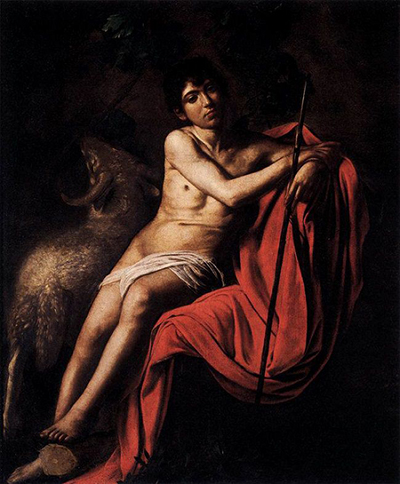John the Baptist 1610 (oil on canvas, 159 x 124 cm), sometimes referred to as John in the Wilderness. It is currently widely accepted that the painting was completed by Michelangelo Merisi da Caravaggio, (1571-1610) circa 1610, during his Sicilian period.
The dating is based on the striking use of colour to be found in his later period, though the date had been disputed in the past. This is one of Caravaggio's last paintings. The original is currently kept and displayed at the Galleria Borghese in Rome. It was completed towards the end of Caravaggio's stay in Naples, after he fled Rome in 1606, and is one of eight known paintings of the Baptist by the artist. The painting embodies the Late Renaissance/Early Baroque depth of emotion and rich interplay of colour, darkness and light (note the lavish use of reds, browns, and whites), as well as the biblical subject matter typical of Counter-Reformation Europe.
The painting captures a scene from the Gospels, with a young John the Baptist (the same figure who would later baptise Christ): here, he appears frail and boyish, with a pensively melancholy expression, gazing into the distance, rather than looking directly at the viewer. He reclines against a dark brown, ominous, background. His contemplation seems simultaneously ethereal and worldly. The 1610 painting stands as an interesting narrative foreshadowing to Caravaggio's earlier depictions of John the Baptist at his beheading (1608), in the same reds and browns, with shadows looming overhead. As in his other traditional representations, John is seen in the wilderness, wearing a white girdle, with a lamb by his side. The lavishly red cloak carelessly draped about his shoulders is the only touch of colour in the painting, making the Baptist appear even more pale and vulnerable, swathed in the scarlet depths. It is a strikingly human depiction of this famous saint: here, he is not just a saint, but also just a wistful boy.
Possibly, life influenced art: by the time Caravaggio began this painting, his life had entered a state of turmoil which may well have informed the sadness evidenced in the painting. Having had to flew Rome in 1606, after accidentally killing his opponent in a street fight, he found himself in prison in Malta in 1608. After his escape, Caravaggio was pursued across Sicily in 1609, before finally taking refuge in Naples, under the protection of the Colonna family. He still hoped to secure pardon which would allow him to return home to Rome, by winning over Cardinal Scipione Borgehese, a collector and patron of art. Caravaggio produced a number of beautiful works to achieve this end. Unfortunately, he died en route to receiving his pardon, at Porto Ercole, north of Rome. The painting found its way into the Borghese collection by 1613, and there it remains, beside the other masterpieces acquired by the Cardinal, though the Villa Borghese is now the Galleria Borghesi.




